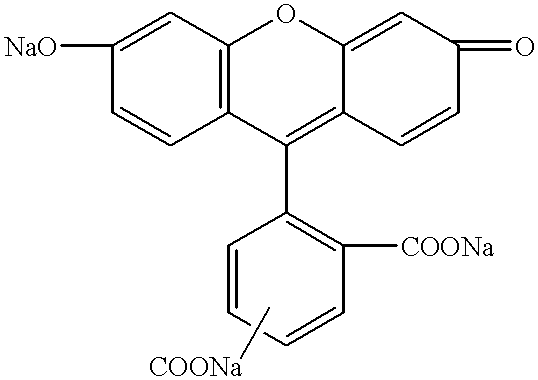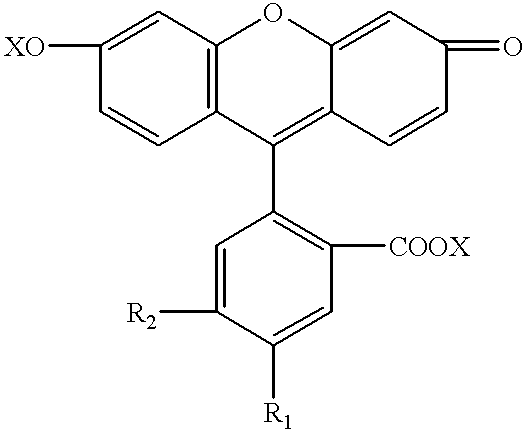Method for detecting neuronal degeneration and anionic fluorescein homologue stains therefor
a technology of anionic fluorescein and neuronal degeneration, which is applied in the field of postmortem detection and localization of degenerated neurons in brain slices, can solve the problems of prone to false positives, shrunken and hyperchromatic cells, and difficult to demonstrate this phenomenon, etc., and achieves simple and reliable use, easy to interpret, and high sensitive
- Summary
- Abstract
- Description
- Claims
- Application Information
AI Technical Summary
Benefits of technology
Problems solved by technology
Method used
Image
Examples
Embodiment Construction
The two anionic fluorescein based fluorescent stains embodying the present invention are 1) the water soluble, tribasic salt of a mixture of the fluorescein isomers 5-carboxyfluorescein and 6-carboxyfluorescein and 2) the water soluble tetrabasic salt of 5,6 dicarboxyfluorescein. The two preferred fluorescent stains of the present invention are the trisodium fluorescein salt, trisodium 5 / 6-carboxyfluorescein, which has the following structure: ##STR1##
And the tetrasodium 5,6-tricarboxyfluorescein which has the following structure: ##STR2##
The abovetrisodium 5,6-carboxyfluorescein and tetrasodium 5,6-carboxyfluorescein both provide a simple, sensitive, and reliable new method for demonstrating and localizing neuronal degeneration.
The respective tribasic and tetrabasic salts of 5 / 6-carboxyfluorescein and 5,6-dicarboxyfluorescein embodying the present invention may be shown by the following general formula: ##STR3##
wherein R.sub.1 and R.sub.2 =--COOX, or --H (provided that both do not=...
PUM
 Login to View More
Login to View More Abstract
Description
Claims
Application Information
 Login to View More
Login to View More - R&D
- Intellectual Property
- Life Sciences
- Materials
- Tech Scout
- Unparalleled Data Quality
- Higher Quality Content
- 60% Fewer Hallucinations
Browse by: Latest US Patents, China's latest patents, Technical Efficacy Thesaurus, Application Domain, Technology Topic, Popular Technical Reports.
© 2025 PatSnap. All rights reserved.Legal|Privacy policy|Modern Slavery Act Transparency Statement|Sitemap|About US| Contact US: help@patsnap.com



